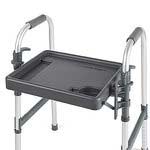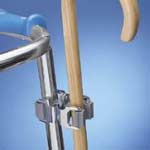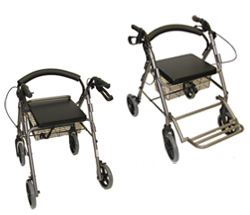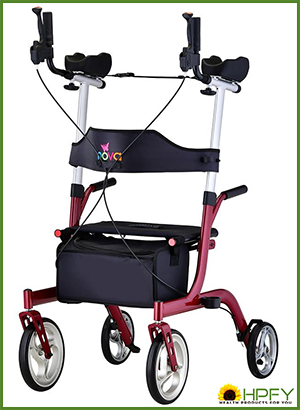Combination Rollator Transport Chair
Combination rollator walker and transport chair are a fairly new product line created by walker manufacturers in the last few years. Because it became obvious to some manufacturers that people were going to use rollator walkers as transport devices in spite of the safety risks of riding on them they redesigned their products to accommodate the users.
The combination rollator transport chair is used from behind just like any other rollator walker when the user is walking but when the user is tired and needs to be pushed the backrest is reversed, a foot rest is lowered on the front and the user sits on the seat facing forward while a care giver pushes the walker from behind.
Height Adjustment
- Wheels - Because the weight load on the wheels is much higher on the rollator transport chair than on a conventional rollator the wheels are normally the larger 8" size normally found on rollator walkers. Smaller wheels could contribute to tipping if a bump was hit while transporting a user and should be avoided.
- Brakes - Rollator transport chairs have a braking system similar to the hand brakes on a bicycle that will slow the walker or stop it when squeezed. In addition to working like conventional brake system rollator brake systems will have a way of being locked on for safety during different situations such as when the user is seated resting or parked.
- Seats - All the rollators I know of have some type of seat. The seats are simple flat surfaces, usually padded, that can usually be flipped up to allow the user to walk within the walker instead of behind the walker. The seats are normally intended for sitting & resting, not for sitting on and pushing ones self around backwards with their legs and not for sitting on while someone else pushes the user around. The combination rollator transport chair is designed for transporting the user on the seat but not for sitting and pushing oneself along with their feet.
- Backrests - The rollator transport chair will usually be a simple metal bar that has some padding on it as a back rest that can be reversed as needed. The back rest on a walker is not intended for support, but is intended to prevent the user from sitting too far forward on the walker and creating forward instability. It will also serve as a reminder that the user can not lean too far back which again will create some instability.
- Baskets and Walker Bags - Most rollators will have one or the other with some having both. They are usually mounted fairly low on the frame to enhance stability and can be mounted either on the front of the walker or under the seat. The can be a security issue if the basket is on the front of the walker because the user can't see it when seated. The "under-seat" baskets are much more secure but inaccessible when the user is seated. The user will have to decide which type is best for their situation.
- Folding Frames - Because it is expected by the manufacturer that these walkers will be taken to different locations and must be loaded into vehicles rollator walkers will all have some type of folding mechanism. Baskets and bags are always removable and may have to be to fold the walker. Generally these rollators can be folded by lifting on the seat mechanism which will also release the lock that prevents the walker from folding accidently while in use.
Height Adjustment
Setting the proper height for a rollator transport chair is the same as any other rollator and is important for the comfort, safety and posture of the user. Generally the top of the walker's hand grips should be at the same height as the user's wrist where it meets the hand when the user is standing as upright as they can. The important thing is there should be a small bend in the user's elbow when using the walker.
Unlike the standard walkers where the handle height is adjusted by moving the wheels up and down, most rollator walkers are adjusted by adjusting the handles up and down.
How to Use a Combination Rollator
As a Rollator Walker
Using the rollator transport chair is pretty straight forward. The user has the walker in front of them, steps into it from the rear and pushes it forward at the same time. The pace is fairly conventional for walking instead of the stop and go pace of a standard walker without wheels. Because the front wheels will swivel, the walker should never have to be picked up by the user while in use.
The user can operate the brakes while walking to slow down and stop or locked on. The brakes should always be locked on when the user is in the process of sitting or standing, whether they are using the walker seat or another seating surface and when they are seated on the walker resting.
As a Transport Chair
- When used as a transport chair the backrest is removed and re-attached facing the opposite way.
- The front of the rollator will have a foot rest of some type on the front that will flip down into position and support the user's feet. (Please note that when used as a transport chair the feet must be supported to prevent injury)
- The user sits on the seat facing forward while a care giver pushes them using the rollator handles.
- The care giver can use the brakes to slow of park the transport chair as needed.
Accessories Available
Because rollators have many features as standard equipment there are only a couple of accessories available for these walkers.
- Trays - While most of the rollator walker models do not offer trays as either optional or standard equipment, most rollators can be set up with some type of tray from after market manufacturers. Trays can be helpful for transporting meals or other items while moving around.
- Cup Holders - Cup holders are pretty much an after market item but really the only way to carry a drink on a walker without spilling it. One bump when carrying a drink on a tray and you'll be heading back to the kitchen for a refill.
- Cane Holders - One might wonder why a person using a walker would need to bring along with them but for those who are able to use a cane for short distances, but need a walker for longer distances, having a cane with them is an asset. Getting into a small bathrooms, voting booths, narrow aisles, change rooms and other small places is often difficult, if not impossible, for someone using a rollator walker.





 Online Vendors
Online Vendors  US Online Vendors
US Online Vendors 


